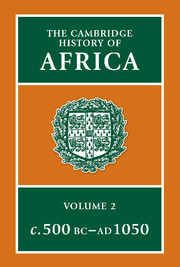Book contents
- Frontmatter
- Introduction
- 1 The legacy of prehistory: an essay on the background to the individuality of African cultures
- 2 North Africa in the period of Phoenician and Greek colonization, c. 800 to 323 BC
- 3 North Africa in the Hellenistic and Roman periods, 323 BC to AD 305
- 4 The Nilotic Sudan and Ethiopia, c. 660 bc to c.ad 600
- 5 Trans-Saharan contacts and the Iron Age in West Africa
- 6 The emergence of Bantu Africa
- 7 The Christian period in Mediterranean Africa, c.ad 200 to 700
- 8 The Arab conquest and the rise of Islam in North Africa
- 9 Christian Nubia
- 10 The Fatimid revolution (861–973) and its aftermath in North Africa
- 11 The Sahara and the Sudan from the Arab conquest of the Maghrib to the rise of the Almoravids
- Bibliographical essays
- Bibliography
- Index
- Plate Sections
- Plate Sections
- Plate Sections
- References
1 - The legacy of prehistory: an essay on the background to the individuality of African cultures
Published online by Cambridge University Press: 28 March 2008
- Frontmatter
- Introduction
- 1 The legacy of prehistory: an essay on the background to the individuality of African cultures
- 2 North Africa in the period of Phoenician and Greek colonization, c. 800 to 323 BC
- 3 North Africa in the Hellenistic and Roman periods, 323 BC to AD 305
- 4 The Nilotic Sudan and Ethiopia, c. 660 bc to c.ad 600
- 5 Trans-Saharan contacts and the Iron Age in West Africa
- 6 The emergence of Bantu Africa
- 7 The Christian period in Mediterranean Africa, c.ad 200 to 700
- 8 The Arab conquest and the rise of Islam in North Africa
- 9 Christian Nubia
- 10 The Fatimid revolution (861–973) and its aftermath in North Africa
- 11 The Sahara and the Sudan from the Arab conquest of the Maghrib to the rise of the Almoravids
- Bibliographical essays
- Bibliography
- Index
- Plate Sections
- Plate Sections
- Plate Sections
- References
Summary
SETTING THE STAGE
The ethnographer or economist – as, indeed, most social scientists – begins with the advantage that he is studying living people. His conclusions are based upon his own direct observations of human behaviour and of the structural organizations that man has developed to enable him to adjust to the changing patterns of his society. The historian also possesses this advantage, though usually at second hand, through the personalities and personal records of the past preserved in the written word. The archaeologist – or rather the palaeo-anthropologist, which would be a more accurate description of him – has no such advantage. No identifiable personalities project themselves from the stage on which his nameless actors play their part and he has no script from which to discover their characteristics; thus most things about them – their abilities, emotions, aspirations and limitations – are likely never to be known, Fortunately however not all understanding need be lost, for an increasing amount of information is becoming available through knowledge of the context in which the changing pattern of human behaviour took place Although as one scene follows another and the scenario and props of the earlier ones become dispersed, lost or disarranged, interpretation is rendered more difficult or ambiguous yet the closer in, time to the present, the more complete are the sets and the more recognizably are the players related to some of those who still walk the stage today so that the more reliable will be the reconstruction possible from a study of their habits and behaviour When all this information is gathered together and correlated, palaeo-anthropologists have a basis for interpreting the more distant past and so for reconstructing the life and ways of the actors.
- Type
- Chapter
- Information
- The Cambridge History of Africa , pp. 11 - 86Publisher: Cambridge University PressPrint publication year: 1979
References
- 1
- Cited by



